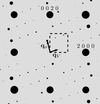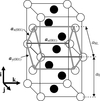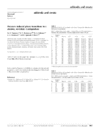issue contents
August 2012 issue

Cover illustration: A high-angle annular darkfield scanning transmission electron microscopy image of the decagonal quasicrystal Al72Co8Ni20 overlaid with a structure model. Clusters of type 1 (occupied center) highlight transition metal sites (white spheres) and clusters of type 2 (empty center) possess both transition metal and mixed aluminum/transition metal (red) sites. Decagonal-shaped clusters are outlined and exhibit two types of overlap as a unifying building feature of aperiodic quasicrystals of decagonal Al-Co-Ni, Al-Co-Cu and Al-Fe-Ni [Deloudi et al. (2011). Acta Cryst. B67, 1-17, based on Abe & Tsai (2004) J. Non-Cryst. Solids, 334, 198-201]. The 2011 Nobel prize in chemistry was awarded to D. Shechtman for his discovery of quasicrystals.
research papers






















addenda and errata



 journal menu
journal menu





























